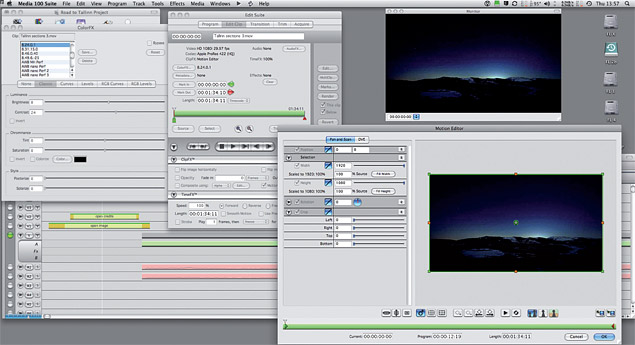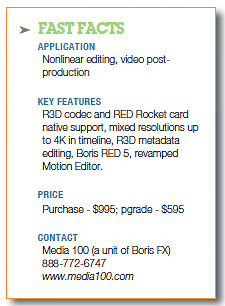Media 100 Suite v.2
Amid the hubbub of this year's NAB Show and Apple's sneak peek at the forthcoming Final Cut Pro X, you may have missed the release of Media 100 Suite v.2. Or maybe you noticed it, thought fondly about the NLE that you quickly learned to cut on and then moved away from when the former owner's status looked uncertain and developments were minimal, and wondered whatever became of Media 100. (It was bought and has been developed and advanced by Boris FX.) With the release of version 2 of the Suite, Media 100 proves itself again to be a full featured, affordable, easy to use, stable, and flexible production tool.
FEATURES
Here's the quick overview. Media 100 can run as software only, or in conjunction with AJA hardware (Kona 3, 3G, LHi, LHe, and LSe cards), the Matrox MXO2 line, and several Blackmagic Design I/O devices (Intensity Pro, DeckLink SDI, DeckLink Studio, and DeckLink HD Extreme). Media 100 Suite v.2 is Macintosh-only and operates only on Intel processors running a minimum of Mac OS X 10.6.6 (Snow Leopard). The timeline features two main video tracks (A/B) with as many as 99 graphics tracks for overlays, titles, and effects, all of which have key-frame-able opacity. Up to 24 audio tracks can be assigned to as many as eight output buses, and built-in EQ, compression, and reverb can be applied at will. Boris RED v.5 is integrated into the Edit Suite for titling, custom transitions, advanced compositing and keying, effects and advanced color correction.
One of the additions to the new version of Media 100 is native support for R3D footage and the RED Rocket card (for accelerated rendering). This means that RED camera footage at up to 4K resolutions can be used without rendering. Along with R3D support comes integrated metadata editing (at this time only for R3D footage, but hopefully a portent of functions to come for other metadata-bearing codecs).

The Media 100 v.2 user interface
Media 100 now supports 2K and 4K resolutions, 16:9 and 2:1 aspect ratios, and frame rates ranging from 23.98 to 59.94. Timelines can now contain a mix of resolutions, codecs, and frame rates, but not different audio sample rates; the application will automatically convert and resize the different clip to the timeline's standard. This automatic action can be modified in the newly revamped and key-frame-able Motion Editor. This is a feature that was formerly available directly from the Edit Suite window; its functionality was replaced a number of versions ago by the inclusion of Boris RED. The Motion Editor can perform scaling, rotation, pan and scan, cropping, and other DVE effects on a clip in the timeline; and in most cases, on most systems it will do so without the need for rendering. Boris RED v.5—also included in this update—features a redesigned interface (single window), more than 60 new filters, improved support for After Effects plug-ins, a curve editor for effects timing, and up to 150 percent faster rendering.
Newly added also is the Catch Frame window, with a Pixel Accurate option, which lets the user see even a 4K frame at full size and resolution for focus checking and color correction frame matching. Finally—among the major new features—is a revamped ColorFX window (now modeless), which allows it to stay open all the time for quicker and easier color correction among clips. Minor, but useful and welcome, improvements include improved search features when importing or relinking clips and better color fidelity through a choice of color space when importing QuickTime clips.
IN USE
Media 100 has long been my NLE of choice, so I immediately installed the new version into my Snow Leopard-based MacPro tower. Installation (un-installation first) was a breeze, and in about five minutes, I was able to start working on some current projects, one of which was a high-definition video meant for projection behind a symphonic performance. I did all the basic compositing, which was extensive, in the built-in Boris RED, which allowed me to easily work to the change points in the musical score. I really appreciated the speed at which RED renders in this new version, as this allowed my workflow to keep up with my idea flow. The Boris Continuum Complete filters that are installed with RED are excellent and widely varied, from particle systems to color correction to keyers to blurs and distortions, but I couldn't help but miss some of my favorite and often used After Effects plug-ins. At this point, plug-ins from DigiEffects function inside RED; I long for the day when more plug-in developers will take the steps necessary to make their software similarly compatible.
The next couple of layers of composites were made up of standard-definition footage transferred from old 8 mm film, and giving me the opportunity to put the new Motion Editor to use. While the Motion Editor can only work with footage in the timeline, and does not do anything RED cannot do, it is really preferable for the tasks that it does. It is fast, incredibly easy to use, and plays in the timeline in real time (anything more complex than a text layer in RED plays as a preview inside RED, but requires rendering in the timeline). The end result is that this feature smoothed and speeded my workflow. Like the implementation of any new and well-designed feature should be, it was very easy to incorporate the Motion Editor into the muscle memory that is my workflow.
While not part of the new feature set, audio features always figure large in my post-production workflow. Audio edits and cross-fades, while not sample or waveform-based, are accurate and easy to do, and the built-in audio filters (EQ, compression, reverb) are quite musical and effective. If anything requires more drastic work, media moves in and out of Media 100 through file and XML export and import. In terms of this current project, the bus system meant I could have several mix and output options. In this case, I needed both a stereo output (for DVD distribution) and a multichannel QuickTime output for performance, each with a different sonic treatment. Setting up the output busses with different EQ, compression, and reverb was no problem and produced the results that I needed on export and playout.
SUMMARY
One of my theories about software non-linear editors (and about post production work in general) has always been that a single tool should not be expected to do all facets of a job equally well, but should be a fast and efficient hub that can do a lot of things correctly and provide a comfortable and well-lit place to hang out and work. Like clothing or home décor, an NLE winds up being a very personal choice, extremely influenced by practical details. Media 100's development over the years has had its rough patches after a stellar start, and lost a lot of attention along the way. Boris FX purchased Media 100 a number of years ago and began on the current development path, featuring modest steps in a highly prioritized direction.
At this point in time, Media 100 is easily comparable with the feature sets of other modern NLE's, exceeding some in some features and lagging a bit behind in others. This new update opens Media 100 up to a wider range of resolutions, to R3D footage and metadata (part of the way of the future), and overall a fast, stable, feature rich workspace. When I'm working, I don't feel like I have to struggle against some developer's preconception of how I should be doing things, indicative of good interface and work flow design. For those who have not looked at Media 100, or not looked lately, now might be a good time to do a drive by, download the trial, watch the Webinar recording of the new features, demoed by the excellent Floh Peters, and see how far the application has developed and how pleasant and efficient working inside Media 100 can be.
I need to note that shortly before this review went to press, Media 100 announced that Suite v.2 is now compatible with Mac OSX 10.7 Lion.
Michael Hanish operates Free Lunch, a video/audio/multimedia production house near Guilford, Vt. He may be contacted at michael@freelunchmedia.com.

Get the TV Tech Newsletter
The professional video industry's #1 source for news, trends and product and tech information. Sign up below.
